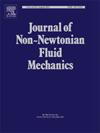The movement of particles in Taylor–Couette flow of complex fluids
IF 2.8
2区 工程技术
Q2 MECHANICS
引用次数: 0
Abstract
A drilling process comprises a drill-pipe rotating within a borehole where fluid is pumped down the pipe and returns, with drilled cuttings, along the annulus. Predominantly the axis of the system is horizontal. Thus, in the absence of axial flow the process geometry is that of a Taylor–Couette flow. Formulated drilling fluids themselves are usually regarded as Bingham or Hershel-Bulkley in nature, but nevertheless encompass elastic behaviour. We have thus studied the distribution of dense (i.e. sedimenting) non-Brownian solid particles in Taylor–Couette flow of model drilling fluids as a function of center body rotation speed. In all cases Taylor vortices are formed above some critical, fluid dependent, Taylor number. However, depending on the fluid properties, particles decorate the vortices differently: particles in a polymeric fluid move to the centroids of the vortices, whereas in a colloidal fluid they move to the outer periphery of the vortices, as previously observed for Newtonian fluids. With a mixed fluid, a clear transition between the two regimes is found. We postulate that this behaviour is a result of a balance between elastically derived lift forces and inertially driven Saffman lift forces acting antagonistically on the particles.
复杂流体泰勒-库埃特流中粒子的运动
钻井过程包括在井眼内旋转的钻杆,流体被泵入管内,并随钻出的岩屑沿着环空返回。系统的轴线主要是水平的。因此,在没有轴流的情况下,过程的几何形状是泰勒-库埃特流。配方钻井液本身通常被认为是宾厄姆或赫尔谢尔-巴克利性质的,但仍然包含弹性行为。因此,我们研究了模型钻井液Taylor-Couette流中致密(即沉积)非布朗固体颗粒随中心体转速的分布。在所有情况下,泰勒涡都是在某个依赖于流体的临界泰勒数以上形成的。然而,根据流体性质的不同,粒子会以不同的方式装饰漩涡:聚合物流体中的粒子会移动到漩涡的质心,而胶体流体中的粒子会移动到漩涡的外围,这与之前在牛顿流体中观察到的情况一样。在混合流体中,可以发现两种状态之间的明显过渡。我们假设这种行为是弹性升力和惯性驱动的萨弗曼升力之间平衡的结果,萨弗曼升力对颗粒起拮抗作用。
本文章由计算机程序翻译,如有差异,请以英文原文为准。
求助全文
约1分钟内获得全文
求助全文
来源期刊
CiteScore
5.00
自引率
19.40%
发文量
109
审稿时长
61 days
期刊介绍:
The Journal of Non-Newtonian Fluid Mechanics publishes research on flowing soft matter systems. Submissions in all areas of flowing complex fluids are welcomed, including polymer melts and solutions, suspensions, colloids, surfactant solutions, biological fluids, gels, liquid crystals and granular materials. Flow problems relevant to microfluidics, lab-on-a-chip, nanofluidics, biological flows, geophysical flows, industrial processes and other applications are of interest.
Subjects considered suitable for the journal include the following (not necessarily in order of importance):
Theoretical, computational and experimental studies of naturally or technologically relevant flow problems where the non-Newtonian nature of the fluid is important in determining the character of the flow. We seek in particular studies that lend mechanistic insight into flow behavior in complex fluids or highlight flow phenomena unique to complex fluids. Examples include
Instabilities, unsteady and turbulent or chaotic flow characteristics in non-Newtonian fluids,
Multiphase flows involving complex fluids,
Problems involving transport phenomena such as heat and mass transfer and mixing, to the extent that the non-Newtonian flow behavior is central to the transport phenomena,
Novel flow situations that suggest the need for further theoretical study,
Practical situations of flow that are in need of systematic theoretical and experimental research. Such issues and developments commonly arise, for example, in the polymer processing, petroleum, pharmaceutical, biomedical and consumer product industries.

 求助内容:
求助内容: 应助结果提醒方式:
应助结果提醒方式:


